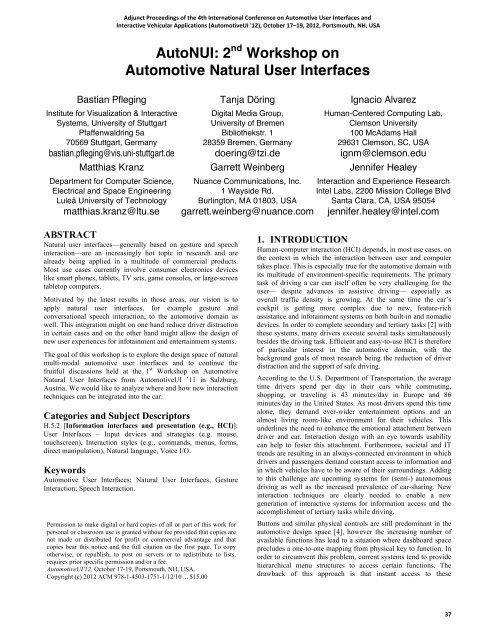12: Adjunct Proceedings - Automotive User Interfaces and ...
12: Adjunct Proceedings - Automotive User Interfaces and ...
12: Adjunct Proceedings - Automotive User Interfaces and ...
You also want an ePaper? Increase the reach of your titles
YUMPU automatically turns print PDFs into web optimized ePapers that Google loves.
Bastian Pfleging<br />
Institute for Visualization & Interactive<br />
Systems, University of Stuttgart<br />
Pfaffenwaldring 5a<br />
70569 Stuttgart, Germany<br />
bastian.pfleging@vis.uni-stuttgart.de<br />
Matthias Kranz<br />
Department for Computer Science,<br />
Electrical <strong>and</strong> Space Engineering<br />
Luleå University of Technology<br />
matthias.kranz@ltu.se<br />
<strong>Adjunct</strong> <strong>Proceedings</strong> of the 4th International Conference on <strong>Automotive</strong> <strong>User</strong> <strong>Interfaces</strong> <strong>and</strong><br />
Interactive Vehicular Applications (<strong>Automotive</strong>UI '<strong>12</strong>), October 17–19, 20<strong>12</strong>, Portsmouth, NH, USA<br />
AutoNUI: 2 nd Workshop on<br />
<strong>Automotive</strong> Natural <strong>User</strong> <strong>Interfaces</strong><br />
ABSTRACT<br />
Natural user interfaces—generally based on gesture <strong>and</strong> speech<br />
interaction—are an increasingly hot topic in research <strong>and</strong> are<br />
already being applied in a multitude of commercial products.<br />
Most use cases currently involve consumer electronics devices<br />
like smart phones, tablets, TV sets, game consoles, or large-screen<br />
tabletop computers.<br />
Motivated by the latest results in those areas, our vision is to<br />
apply natural user interfaces, for example gesture <strong>and</strong><br />
conversational speech interaction, to the automotive domain as<br />
well. This integration might on one h<strong>and</strong> reduce driver distraction<br />
in certain cases <strong>and</strong> on the other h<strong>and</strong> might allow the design of<br />
new user experiences for infotainment <strong>and</strong> entertainment systems.<br />
The goal of this workshop is to explore the design space of natural<br />
multi-modal automotive user interfaces <strong>and</strong> to continue the<br />
fruitful discussions held at the 1 st Workshop on <strong>Automotive</strong><br />
Natural <strong>User</strong> <strong>Interfaces</strong> from <strong>Automotive</strong>UI ’11 in Salzburg,<br />
Austria. We would like to analyze where <strong>and</strong> how new interaction<br />
techniques can be integrated into the car.<br />
Categories <strong>and</strong> Subject Descriptors<br />
H.5.2 [Information interfaces <strong>and</strong> presentation (e.g., HCI)]:<br />
<strong>User</strong> <strong>Interfaces</strong> – Input devices <strong>and</strong> strategies (e.g. mouse,<br />
touchscreen), Interaction styles (e.g., comm<strong>and</strong>s, menus, forms,<br />
direct manipulation), Natural language, Voice I/O.<br />
Keywords<br />
<strong>Automotive</strong> <strong>User</strong> <strong>Interfaces</strong>; Natural <strong>User</strong> <strong>Interfaces</strong>, Gesture<br />
Interaction; Speech Interaction.<br />
Permission to make digital or hard copies of all or part of this work for<br />
personal or classroom use is granted without fee provided that copies are<br />
not made or distributed for profit or commercial advantage <strong>and</strong> that<br />
copies bear this notice <strong>and</strong> the full citation on the first page. To copy<br />
otherwise, or republish, to post on servers or to redistribute to lists,<br />
requires prior specific permission <strong>and</strong>/or a fee.<br />
<strong>Automotive</strong>UI'<strong>12</strong>, October 17-19, Portsmouth, NH, USA.<br />
Copyright (c) 20<strong>12</strong> ACM 978-1-4503-1751-1/<strong>12</strong>/10 ... $15.00<br />
Tanja Döring<br />
Digital Media Group,<br />
University of Bremen<br />
Bibliothekstr. 1<br />
28359 Bremen, Germany<br />
doering@tzi.de<br />
Garrett Weinberg<br />
Ignacio Alvarez<br />
Human-Centered Computing Lab,<br />
Clemson University<br />
100 McAdams Hall<br />
29631 Clemson, SC, USA<br />
ignm@clemson.edu<br />
Jennifer Healey<br />
Nuance Communications, Inc. Interaction <strong>and</strong> Experience Research<br />
1 Wayside Rd.<br />
Intel Labs, 2200 Mission College Blvd<br />
Burlington, MA 01803, USA Santa Clara, CA, USA 95054<br />
garrett.weinberg@nuance.com jennifer.healey@intel.com<br />
1. INTRODUCTION<br />
Human-computer interaction (HCI) depends, in most use cases, on<br />
the context in which the interaction between user <strong>and</strong> computer<br />
takes place. This is especially true for the automotive domain with<br />
its multitude of environment-specific requirements. The primary<br />
task of driving a car can itself often be very challenging for the<br />
user— despite advances in assistive driving— especially as<br />
overall traffic density is growing. At the same time the car’s<br />
cockpit is getting more complex due to new, feature-rich<br />
assistance <strong>and</strong> infotainment systems on both built-in <strong>and</strong> nomadic<br />
devices. In order to complete secondary <strong>and</strong> tertiary tasks [2] with<br />
these systems, many drivers execute several tasks simultaneously<br />
besides the driving task. Efficient <strong>and</strong> easy-to-use HCI is therefore<br />
of particular interest in the automotive domain, with the<br />
background goals of most research being the reduction of driver<br />
distraction <strong>and</strong> the support of safe driving.<br />
According to the U.S. Department of Transportation, the average<br />
time drivers spend per day in their cars while commuting,<br />
shopping, or traveling is 43 minutes/day in Europe <strong>and</strong> 86<br />
minutes/day in the United States. As most drivers spend this time<br />
alone, they dem<strong>and</strong> ever-wider entertainment options <strong>and</strong> an<br />
almost living room-like environment for their vehicles. This<br />
underlines the need to enhance the emotional attachment between<br />
driver <strong>and</strong> car. Interaction design with an eye towards usability<br />
can help to foster this attachment. Furthermore, societal <strong>and</strong> IT<br />
trends are resulting in an always-connected environment in which<br />
drivers <strong>and</strong> passengers dem<strong>and</strong> constant access to information <strong>and</strong><br />
in which vehicles have to be aware of their surroundings. Adding<br />
to this challenge are upcoming systems for (semi-) autonomous<br />
driving as well as the increased prevalence of car-sharing. New<br />
interaction techniques are clearly needed to enable a new<br />
generation of interactive systems for information access <strong>and</strong> the<br />
accomplishment of tertiary tasks while driving.<br />
Buttons <strong>and</strong> similar physical controls are still predominant in the<br />
automotive design space [4], however the increasing number of<br />
available functions has lead to a situation where dashboard space<br />
precludes a one-to-one mapping from physical key to function. In<br />
order to circumvent this problem, current systems tend to provide<br />
hierarchical menu structures to access certain functions. The<br />
drawback of this approach is that instant access to these<br />
37





